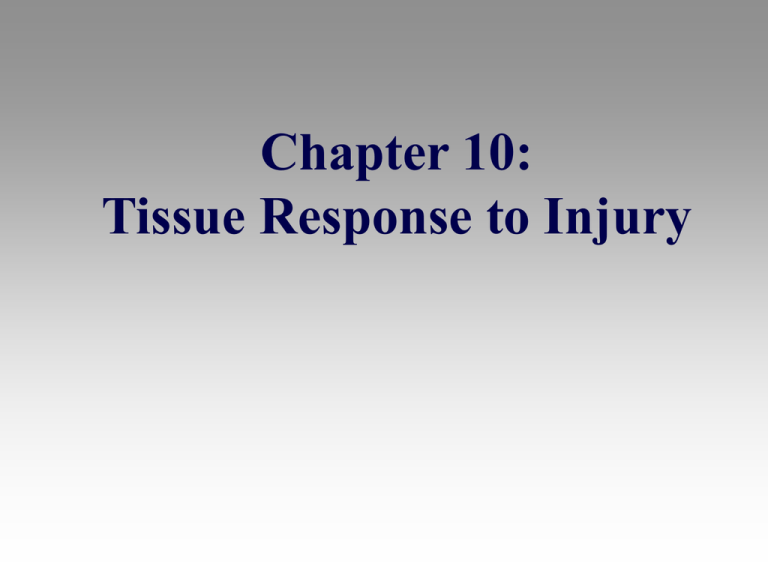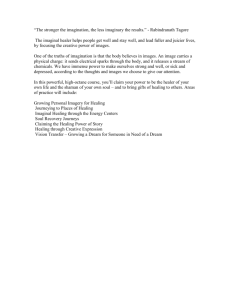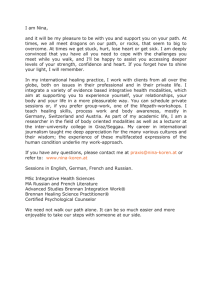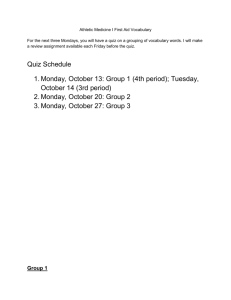HM 100: Prevention & Care Tissue Response to Injury
advertisement

Chapter 10: Tissue Response to Injury Inflammatory Response • Acute Inflammation – Short onset and duration – Change in hemodynamics, production of exudate, granular leukocytes • Chronic Inflammation – Long onset and duration – Presence of non-granular leukocytes and extensive scar tissue Cardinal Signs of Inflammation • • • • • Rubor (redness) Tumor (swelling) Color (heat) Dolor (pain) Functio laesa (loss of function) Phases of the Inflammatory Response (3 separate phases) • 1. Acute phase • 2. Repair phase • 3. Remodeling phase Phase I: Acute Phase • Initial reaction to an injury occurring 3 hours to 4 days following injury • Goal – – – – Protect Localize Decrease injurious agents Prepare for healing and repair • Caused by trauma, chemical agents, thermal extremes, pathogenic organisms • External and internal injury result in tissue death and cell death • Decreased oxygen to area increases cell death • Phagocytosis will add to cell death due to excess digestive enzymes • Rest, ice, compression & elevation are critical to limiting cell death • First hour – Vasoconstriction and coagulation occur to seal blood vessels and chemical mediators are released – Immediately followed by vasodilation or blood vessel • Second hour – Vasodilation decreases blood flow, increased blood viscosity resulting in edema (swelling) • Second hour (continued) – Exudate increases (high concentration of RBC’s) due to increased vessel permeability – Permeability changes generally occur in capillary and venules – Margination occurs causing leukocytes to fill the area and line endothelial walls – Through diapedesis and chemotaxis leukocytes move to injured area • Cellular response – Mast cells (connective tissue cells) and leukocytes (basophils, monocytes, neutrophils) enter area – Mast cells with heparin and histamine serve as first line of defense – Basophils provide anticoagulant – Neutrophils and monocytes are responsible for small and large particles undergoing phagocytosis - ingestion of debris and bacteria • Cellular mediation – Histamine provided by platelets, mast cells and basophils to enhance permeability and arterial dilation – Serotonin provides for vasoconstriction – Bradykinin is a plasma protease that enhance permeability and causes pain. – Heparin is provided by mast cells and basophils to prevent coagulation – Leukotrienes and prostaglandins are located in cell membranes and develop through the arachadonic acid cascade – Leukotrienes alter permeability – Prostaglandin add and inhibit inflammation • Complimentary systems – Enzymatic proteins that destroy bacteria and other cells through their impact on cell lysis • Bleeding and exudate – Amount dependent on damage – Initial stage: thromboplastin is formed – Second stage: Prothrombin is converted to thrombin due to interaction with thromboplastin – Third stage: thrombin changes from soluble fibrinogen to insoluble fibrin coagulating into a network localizing the injury Phase II: Repair Phase • Phase will extent from 48 hours to 6 weeks following cleaning of fibrin clot, erythrocytes, and debris • Repaired through 3 phases – Resolution (little tissue damage and normal restoration) – Restoration (if resolution is delayed) – Regeneration (replacement of tissue by same tissue) • Scar formation – Less viable than normal tissue, may compromise healing – Firm, inelastic mass devoid of capillary circulation – Develops from exudate with high protein and debris levels resulting in granulation tissue – Invaded by fibroblasts and and collagen forming a dense scar and while normally requiring 3-14 weeks may require 6 months to contract • Primary healing (healing by first intention) – Closely approximated edges with little granulation tissue production • Secondary healing (heal by secondary intention) – Gapping, tissue loss, and development of extensive granulation tissue – Common in external lacerations and internal musculoskeletal injuries • Regeneration – Related to health, nutrition and tissue type – Dependent on levels of: • debris (phagocytosis) • endothelial production (hypoxia and macrophages stimulate capillary buds) • production of fibroblasts (revascularization allows for enhanced fibroblast activity and collagen production which is tied to Vitamin C, lactic acid, and oxygen – Phase III: Remodeling • Overlaps repair and regeneration • First 3-6 weeks involves laying down of collagen and strengthening of fibers • 3 months to 2 years allowed for enhanced scar tissue strength • Balance must be maintained between synthesis and lysis • Take into consideration forces applied and immobilization/mobilization time frames relative to tissue and healing time Chronic Inflammation • Result of failed acute inflammation resolution within one month termed subacute inflammation • Inflammation lasting months/years termed chronic – Results from repeated microtrauma and overuse – Proliferation of connective tissue and tissue degeneration Characteristics of Chronic Inflammation • Proliferation of connective tissue and tissue degeneration • Presence of lymphocytes, plasma cell, macrophages(monocytes) in contrast to neutrophils (during acute conditions) • Major chemicals include – Kinins (bradykinin) - responsible for vasodilation, permeability and pain – Prostaglandin - responsible for vasodilation but can be inhibited with aspirin and NSAID’s Factors That Impede Healing • • • • Extent of injury Edema Hemorrhage Poor Vascular Supply • Separation of Tissue • Muscle Spasm • Atrophy • Corticosteroids • Keloids and Hypertrophic Scars • Infection • Humidity, Climate, Oxygen Tension • Health, Age, and Nutrition Soft Tissue Healing • Cell structure/function – All organisms composed of cells – Properties of soft tissue derived from structure and function of cells – Cells consist of nucleus surrounded by cytoplasm and encapsulated by phospholipid cell membrane – Nucleus contains chromosomes (DNA) – Functional elements of cells (organelles) include mitochondria, ribosomes, endoplasmic reticulum, Golgi apparatus & centrioles Tissues of the Body • Bone - not classified as soft tissue • 4 types of soft tissue – Epithelial tissue • Skin, vessel & organ linings – Connective tissue • Tendons, ligaments, cartilage, fat, blood, and bone – Muscle tissue • Skeletal, smooth, cardiac muscle – Nerve tissue • Brain, spinal cord & nerves Soft Tissue Adaptations • Metaplasia - transformation of tissue from one type to another that is not normal for that tissue • Dysplasia - abnormal development of tissue • Hyperplasia- excessive proliferation of normal cells in normal tissue arrangement • Atrophy- a decrease in the size of tissue due to cell death and re-absorption or decreased cell proliferation • Hypertrophy - an increase in the size of tissue without necessarily changing the number of cells Cartilage Healing • Limited capacity to heal • Little or no direct blood supply • Chrondrocyte and matrix disruption result in variable healing • Articular cartilage that fails to clot and has no perichondrium heals very slowly • If area involves subchondral bone (enhanced blood supply) granulation tissue is present and healing proceeds normally Ligament Healing • Follows similar healing course as vascular tissue • Proper care will result in acute, repair, and remodeling phases in same time required by other vascular tissue • Repair phase will involve random laying down of collagen which, as scar forms, will mature and realign in reaction to joint stresses and strain • Full healing may require 12 months Skeletal Muscle Healing • Skeletal muscle cannot undergo mitotic activity to replace injured cells • New myofibril regeneration is minimal • Healing and repair follow the same course as other soft tissues developing tensile strength (Wolff’s Law) Nerve Healing • Cannot regenerate after injury • Regeneration can take place within a nerve fiber • Proximity of injury to nerve cell makes regeneration more difficult • For regeneration, optimal environment is required • Rate of healing occurs at 3-4 mm per day • Injured central nervous system nerves do not heal as well as peripheral nerves Modifying Soft-Tissue Healing • Varying issues exist for all soft tissues relative to healing (cartilage, muscle, nerves) • Blood supply and nutrients is necessary for all healing • Healing in older athletes or those with poor diets may take longer • Certain organic disorders (blood conditions) may slow or inhibit the healing process Management Concepts • Drug utilization – Anitprostaglandin agents used to combat inflammation – Non-steroidal anti-inflammatory agents (NSAID’s) – Medications will work to decrease vasodilatation and capillary permeability • Therapeutic Modalities – Thermal agents are utilized • Heat stimulates acute inflammation (but works as a depressant in chronic conditions) • Cold is utilized as an inhibitor – Electrical modalities • Treatment of inflammation • Ultrasound, microwave, electrical stimulation (includes transcutaneous electrical muscle stimulation and electrical muscle stimulation • Therapeutic Exercise – Major aim involves pain free movement, full strength power, and full extensibility of associated muscles – Immobilization, while sometimes necessary, can have a negative impact on an injury • Adverse biochemical changes can occur in collagen – Early mobilization (that is controlled) may enhance healing Fracture Healing • Potential serious bone fractures are part of athletics • Time is necessary for proper bone union to occur and is often out of the control of a physician • Conservative treatment will be necessary for adequate healing to occur • Bone undergoes constant remodeling through osteocyte activity • Osteocytes cellular component of bone – Osteoblasts are responsible for bone formation while osteoclasts resorb bone • Cambium (periosteum) – A fibrous covering involved in bone healing – Vascular and very dense • Inner cambium – less vascular and more cellular. – Provides attachments for muscle, ligaments and tendons Acute Fracture of Bone • Follows same three phases of soft tissue healing • Less complex process • Acute fractures have 5 stages – – – – – Hematoma formation Cellular proliferation Callus formation Ossification Remodeling Hematoma Formation • Trauma to the periosteum and surrounding soft tissue occurs due to the initial bone trauma • During the first 48 hours a hematoma within the medullary cavity and the surrounding tissue develops • Blood supply is disrupted by clotting vessels and cellular debris • Dead bone results in an inflammatory response (vasodilation, exudate cell migration) Cellular Formation • Granulation forms constructing fibrous union between fractured ends • Capillary buds allow endosteal cells influx from cambium layer • Cells evolve from fibrous callus to cartilage, to woven bone • High oxygen tension = fibrous tissue • Low oxygen tension = cartilage tissue • Bone growth will occur with optimal oxygen tension and compression Callus Formation • Soft callus is a random network of woven bone • Osteoblasts fill the internal and external calluses to immobilize the site • Calluses are formed by bone fragments that bridge the fracture gap • The internal callus creates a rigid immobilization early • Hard callus formation occurs after 3-4 weeks and lasts 3-4 months • Hard callus is a gradual connection of bone filaments to the woven bone • Less than ideal immobilization produces a cartilagenous union instead of a bony union Ossification • Adequate immobilization and compression will result in new Haversian systems developing • Haversian canals allow for the laying down of primary bone • Ossification is complete when bone has been laid down and the excess callus has been resorbed by osteoclasts. Remodeling • Occurs following callus resorption and trabecular bone is laid along lines of stress • Bioelectric stimulation plays a major role in completing the remodeling process – Osteoblasts are attracted to the electronegative (concave/compression) side – Osteoclasts are attracted to the electropositive (convex/tension) side • The process is complete when the original shape is achieved or the structure can withstand imposed stresses Acute Fracture Management • Must be appropriately immobilized, until Xrays reveal the presence of a hard callus • Fractures can limit participation for weeks or months • A clinician must be certain that the following areas do not interfere with healing – Poor blood supply – Poor immobilization – Infection • Poor blood supply – Bone may die and union/healing will not occur (avascular necrosis) – Common sites include: • Head of femur, navicular of the wrist, talus, and isolated bone fragments – Relatively rare in healthy, young athletes except in navicular of the wrist • Poor immobilization – Result of poor casting allowing for motion between bone parts – May prevent proper union or result in bony deformity • Infection – May interfere with normal healing, particularly with compound fractures – Severe streptococcal and staphylococcal infections – Modern antibiotics has reduced the risk of infections – Closed fractures are not immune to infections within the body or blood • If soft tissue alters bone positioning, surgery may be required to ensure proper union Healing of Stress Fractures • Result of cyclic forces, axial compression or tension from muscle pulling • Electrical potential of bone changes relative to stress (compression, tension, or torsional) • Constant stress axially or through muscle activity can impact bone resorption, leading to microfracture • If osteoclastic activity is not in balance with oesteoblastic activity bone becomes more susceptible to fractures • To treat stress fractures a balance between osteoblast and osteoclast activity must be restored • Early recognition is necessary to prevent complete cortical fractures • Decreased activity and elimination of factors causing excess stress will be necessary to allow for appropriate bone remodeling Pain • Major indicator of injury • Pain is individual and subjective • Factors involved in pain – Anatomical structures – Physiological reactions – Psychological, social, cultural and cognitive factors Nociception • Pain receptors -free nerve endings sensitive to extreme mechanical, thermal and chemical energy • Located in meninges, periosteum, skin, teeth, and some organs • Pain information transmitted to spinal cord via myelinated C fibers and A delta fibers • Nociceptor stimulation results in release of substance P • Signal travels along afferent nerves to the spinal cord – A delta fiber (fast) transmit information to the thalamus concerning location of pain and perception of pain being sharp, bright or stabbing – C fibers (slower conduction velocity) deal with diffused, dull, aching and unpleasant pain – C fibers signal also passed to limbic cortex providing emotional component to pain • Nociceptive stimuli is at or close to an intensity which would result in tissue injury Endogenous Analgesics • Nervous system is electrochemical in nature • Chemicals called neurotransmitters are released by presynaptic cell • Two types mediate pain – Endorphins – Seretonin • Neurotransmitters release stimulated by noxious stimuli- resulting in activation of pain inhibition transmission • Stimulation of periaqueductal gray matter (PGA) and raphe nucleus of pons and medulla cause analgesia • Analgesia is the result of opioids release – Morphine like substance manufactured in the PGA and CNS – Endorphins and enkephalins • Other pain modulators – Norepinephrine (noradrenergic – Seretonin also will serve as neuromodulator Pain Categories • • • • Pain sources Fast versus slow pain Acute versus chronic Projected or referred pain • Pain sources – Cutaneous, deep somatic, visceral and psychogenic – Cutaneous pain is sharp, bright and burning with fast and slow onset – Deep somatic pain originates in tendons, muscles, joints, periosteum and blood vessels – Visceral pain begins in organs and is diffused at first and may become localized – Psychogenic pain is felt by the individual but is emotional rather than physical • Fast versus Slow Pain – Fast pain localized and carried through Adelta axons – Slow pain is perceived as aching, throbbing, or burning (transmitted through C fibers) • Acute versus Chronic Pain – Acute pain is less than six months in duration – Chronic pain last longer than six months – Chronic pain classified by IASP as pain continuing beyond normal healing time • Projected (Referred) Pain – Pain which occurs away from actual site of injury/irritation – Unique to each individual and case – May elicit motor and/or sensory response – A-alpha fibers are sensitive to pressure and can produce paresthesia – Three types of referred pain include: myofascial, sclerotomic, and dermatomic • Myofascial Pain – Trigger points or small hyperirritable areas within muscle resulting in bombardment of CNS – Acute and chronic pain can be associated with myofascial points – Often described as fibrositis, myositis, myalgia, myofasciitis and muscular strain – Two types of trigger points (active and latent) – Active points cause obvious complaint – Latent points are dormant potentially causing loss of ROM – Trigger points do not follow patterns – Trigger point area referred to as reference zone which may or may not be proximal to the point of irritation • Sclerotomic and dermatomic pain – Deep pain with slow or fast characteristics – May originate from sclerotomic, myotomic or dermatomic nerve irritation/injury – Sclerotomic pain transmitted by C fibers causing deep aching and poorly localized pain – Can be projected to multiple areas of brain causing depression, anxiety, fear or anger – Autonomic changes result (vasomotor control, BP and sweating – Dermatomic pain (irritation of A-delta fibers) is sharp and localized – Projects to the thalamus and cortex directly • Gate Theory – Area in dorsal horn of spinal cord causes inhibition of pain impulses ascending to cortex – T-cells will transmit signals to brain – Substantia gelatinosa functions as gate determining if stimulus sent to T-cells – Pain stimuli exceeding threshold results in pain perception – Stimulation of large fast nerves can block signal of small pain fiber input – Rationale for TENS, accupressure/puncture, thermal agents and chemical skin irritants Central Biasing Theory Release of BEndorphins Variation of Pain Sensitivity • Hyperesthesia, paresthia or analgesia • Pain modulation – Mixture of physical and psychological factors – Pain management is a challenge to treat – Generally acute pain management in athletic training setting • Pain assessment – Self report is the best reflection of pain and discomfort – Assessment techniques include: • visual analog scales (0-10, marked no pain to severe pain) • verbal descriptor scales (marked none, slight, moderate, and severe) • Pain Treatment – Must break pain-spasm-hypoxia-pain cycle through treatment – Agents used; heat/cold, electrical stimulation-induced analgesia, pharmacological agents • Heat/Cold – Heat increases circulation, blood vessel dilation, reduces nociception and ischemia caused by muscle spasm – Cold applied for vasoconstriction and prevention of extravasation of blood into tissue – Pain reduced through decrease in swelling and spasm • Induced analgesia – Utilize electrical modalities to reduce pain – TENS and acupuncture commonly used to target Gate Theory • Pharmacological Agents – Oral, injectable medications – Commonly analgesics and antiinflammatory agents Psychological Aspects of Pain • Pain can be subjective and psychological • Pain thresholds vary per individual • Pain is often worse at night due to solitude and absence of external distractions • Personality differences can also have an impact • A number of theories relative to pain exist and it physiological and psychological components • Athlete, through conditioning are often able to endure pain and block sensations of minor injuries







